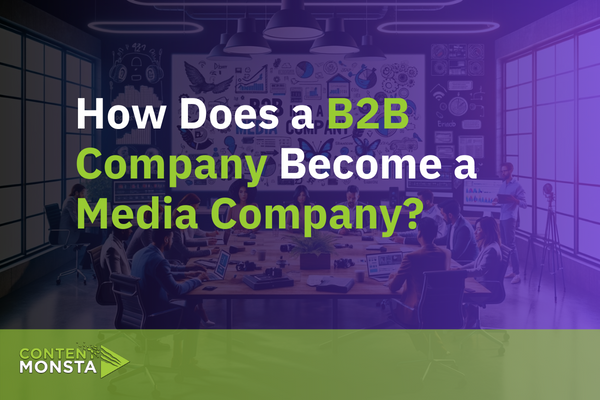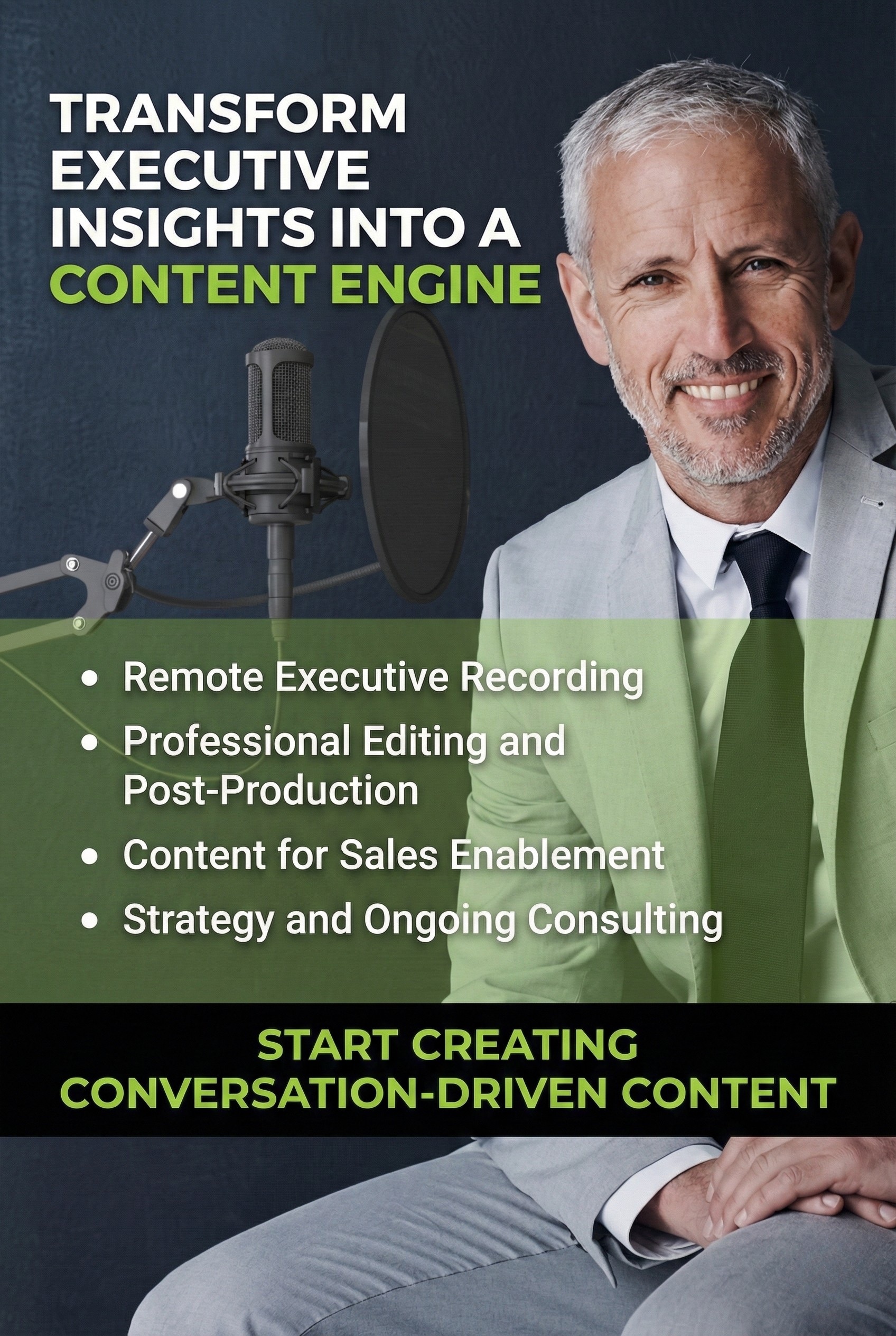Business leaders often hear the advice to “Become a Media Company.” However, this doesn’t resonate as serious business advice. The reason is that although the concept and advice are accurate and valuable, they lack that connection to leadership priorities. As a marketing executive, strategies must be grounded in concrete business objectives.
This article lays out how you can tie the concept of becoming a media company to leadership priorities in a way that resonates with business leaders.

Show Content as a Strategic Asset
Let’s talk about content, not just any content, but content as a strategic asset. In the world of digital marketing, we often hear about the importance of content, but what does it really mean to treat content as an asset? It means recognizing that every piece of content – be it a blog post, video, or podcast – is a building block in your brand’s story and in your relationship with your customers.
First off, think about the unique perspective your brand brings to the table. This isn’t about regurgitating what everyone else is saying. It’s about showcasing your expertise, sharing insights, and providing value that only you can offer. Whether it’s an insightful blog on industry trends or a podcast that dives deep into customer success stories, each piece of content should reinforce your brand’s authority and thought leadership.
But it’s not just about creating content; it’s about creating the right content. This is where a deep understanding of your audience comes into play. Who are they? What challenges do they face? What kind of information can make their lives easier or their businesses more successful? When you align your content with the needs and interests of your audience, you not only grab their attention but also earn their trust and loyalty.
Moreover, this strategic content approach is not a one-and-done deal. It’s an ongoing process of learning and adapting. Use analytics to track how your audience interacts with your content. Which topics resonate the most? What format do they prefer? This data is gold. It helps you refine your content strategy, ensuring that every piece of content you produce is not just good, but great – great in terms of engaging your audience and driving the desired outcomes.
Treating content as a strategic asset means looking at each piece of content through a strategic lens. It’s about creating content that builds your brand, engages your audience, and continuously evolves based on insights and data. In the end, it’s about leveraging content to forge a stronger, more meaningful connection with your customers.

Create Support for Your Brand’s Story
While it’s been overused, storytelling isn’t just a buzzword; it’s a fundamental way of connecting with your audience. It’s about crafting a narrative around your brand that resonates with your customers on a personal level. This isn’t about listing product features or boasting about your company’s achievements. It’s about humanizing your brand and making it relatable.
What makes your brand unique? Maybe it’s your company’s origin story, the challenges you’ve overcome, or the values that drive your business. These are the stories that stick with your audience, the ones they remember and share. When you tell these stories, you’re not just selling a product or service; you’re inviting your audience into a narrative where they can see themselves.
For example, if your brand focuses on sustainability, don’t just talk about your eco-friendly products. Tell the story of why sustainability matters to you. Share stories of the impact your company has on the environment and communities. These stories create an emotional connection that goes beyond the transactional nature of buying and selling.
And remember, storytelling is not a one-way street. It’s about creating a dialogue with your audience. Encourage your customers to share their stories – how your product or service has impacted their lives or aligned with their values. This not only deepens the customer relationship but also provides you with authentic content that can be more impactful than any marketing copy.
Brand storytelling is about finding the heart and soul of your brand and sharing it in a way that resonates with your audience. It’s about being authentic, relatable, and engaging. In a world where consumers are bombarded with countless marketing messages every day, a good story can be your most powerful tool to stand out and create lasting connections.

Ensure Integrated Marketing Communication
Considering the multiple channels pulling from the marketing budget, integration of all of those channels is key. Gone are the days when different marketing channels operated in silos. Today, a cohesive and integrated approach is not just preferred but necessary. It’s about ensuring that your brand message is consistent, whether a customer sees it on a social media post, a billboard, or hears it in a podcast.
Think of your brand message as a thread weaving through every marketing channel. This consistency reinforces your brand identity and helps build trust with your audience. It’s not about repeating the same message in the same way across all channels. Instead, it’s about adapting your core message to fit the unique strengths and audience of each channel while maintaining a cohesive brand narrative.
For instance, your social media platforms can be used to showcase the more human side of your brand – behind-the-scenes content, customer stories, quick tips, and updates. Your website, on the other hand, might go deeper into your products and services, offering more detailed information and resources. Despite the difference in content depth and style, the underlying message about who you are and what you stand for remains constant.
This integration also extends to the alignment between your marketing and sales teams. It’s crucial that the message conveyed in your marketing materials is reflected in your sales conversations. Consistency across these touchpoints not only strengthens your brand image but also enhances the customer experience.
Integrated marketing communication isn’t just a strategy; it’s a necessity in today’s fragmented media landscape. It ensures that your brand story is told consistently and effectively, no matter where or how your audience encounters it. By integrating your communication efforts, you create a seamless and more compelling brand experience for your customers.

Emphasize Innovation and Adaptability
Innovation and adaptability are essential for a brand to thrive. Embracing a media-centric approach in marketing is a testament to a brand’s ability to adapt to the changing landscape and innovate in the way it communicates and engages with its audience.
Innovation in this context means experimenting with new formats and channels to see what resonates with your audience. It’s about staying ahead of the curve, whether that’s through interactive content, augmented reality experiences, or leveraging emerging social platforms. For example, if your target audience is increasingly consuming content through podcasts, then innovating by starting a podcast series can be a strategic move. It shows that you’re in tune with your audience’s preferences and willing to meet them where they are.
Adaptability, on the other hand, is about being responsive to the changing market dynamics and customer needs. It involves continuously analyzing your marketing strategies and being ready to pivot when necessary. This could mean shifting your content strategy in response to new consumer trends or revising your messaging to align with current events. It’s about staying relevant and maintaining a connection with your audience, even as their behaviors and preferences evolve.
Innovation and adaptability also extend to internal processes. It involves adopting new technologies and methodologies to streamline content creation and distribution, ensuring that your marketing efforts are as efficient and effective as possible.
Incorporating innovation and adaptability into your media-centric marketing approach is crucial. It not only helps in keeping your content fresh and engaging but also ensures that your brand stays relevant and top-of-mind in an ever-evolving digital landscape. By being innovative and adaptable, you demonstrate that your brand is forward-thinking and customer-focused, qualities that are highly valued in today’s market.

Focus on ROI and Revenue Generation
When we talk about content and media from a marketing perspective, ultimately, it all circles back to the bottom line: ROI and revenue generation. It’s essential to understand that a media-centric approach isn’t just about creating content or building brand presence; it’s about strategically leveraging these efforts to drive tangible business results.
First, let’s look at direct revenue generation. This can come in many forms, depending on your business model. It could be through sponsored content, affiliate marketing, or selling digital products like e-books or webinars. The key here is to align your content with revenue-generating opportunities without compromising the authenticity and value that draw your audience in the first place.
Then there’s indirect revenue generation, which, in many ways, is equally important. This includes increased brand visibility leading to new customer acquisition, enhanced customer loyalty resulting in repeat business, and stronger brand authority fostering trust and credibility in the market. While these benefits might not translate into immediate revenue, they are crucial for long-term business growth and stability.
For example, consider a comprehensive content strategy that includes SEO-optimized articles, engaging social media posts, and informative webinars. This approach not only attracts potential customers through various channels but also nurtures them through the sales funnel. By providing valuable content at each stage of the customer journey, you’re not just selling; you’re building relationships. And these relationships often translate into sales, either directly or through referrals.
A media-centric approach in marketing should always be tied back to ROI and revenue generation. It’s not just about content creation and distribution; it’s about creating content that drives business growth. By focusing on both direct and indirect revenue generation opportunities, you ensure that your media efforts contribute to your company’s financial success.

The Wrap
The transformation of a B2B company into a media entity is much more than a trendy catchphrase; it’s a strategic realignment of your marketing approach to meet the demands of a rapidly evolving digital landscape. By treating content as a strategic asset, we can harness the power of brand storytelling to forge deeper connections with our audience. Integrated marketing communication ensures that our message is consistently and effectively delivered across all channels, resonating with our customers in a unified voice.
Through innovation and adaptability, we stay ahead, continually evolving our strategies to meet the ever-changing needs and preferences of our audience. And most importantly, by focusing on ROI and revenue generation, we ensure that our media-centric endeavors contribute directly to our business’s growth and success. Embracing these principles transforms the concept of becoming a media company from a vague notion into a concrete, actionable strategy that aligns with our leadership priorities and drives our business forward.

The SAUCE Framework For Better Content Marketing
My niece has been one to keep a hot sauce bottle in her purse long before Beyoncé mentioned it. She doesn’t settle for mediocre flavor and has a backup to

How Much Does it Cost to Hire a Podcast Production Company?
A quick breakdown of what it should cost to hire a podcast production company to help you with your podcast production and promotion.

36 Video and Podcast Content Frequently Asked Questions
Expert answers to remote podcast and video production questions. How remote recording works, options for support, pricing, ROI, and analytics.




